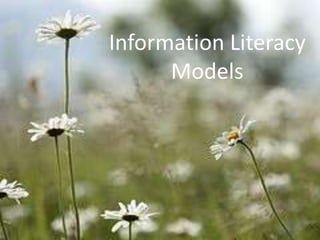
Information Literacy Models Through the Ages
- 3. Big Blue Connect JISC 2003
- 4. Sharon Markless and David Streatfield 2007
- 8. Three Spheres of Information Literacy Becoming information literate takes place in a wider social context determined by roles, norms and tasks Find/ access/ locate Spheres can occur in no particular order Evaluate/ discern Use/ communicate/ produce Each sphere triggers its own set of behavioural, cognitive, metacognitive and affective states. Geoff Walton 2009
- 9. Bibliography SCONUL 7 Pillars Model http://www.sconul.ac.uk/groups/information_literacy/seven_pillars.html JISC Big Blue Connect Model http://www.library.mmu.ac.uk/bbconnect/ismodel.pdf Markless S. & Streatfield D. (2007) Three decades of information literacy: redefining the parameters in; Andretta S. (Ed.) Change and Challenge: Information literacy for the 21st Century. Auslib: Adelaide. http://www.informat.org/pdfs/Streatfield-Markless.pdf Walton, G. Demolishing the Seven Pillars: a warning from research? http://www.lilacconference.com/dw/programme/Presentations/Tuesday/City_View_Suite/Walton_Demolishing.pdf
- 10. Photo credits Daisies and Ladybird by DeadYankee http://www.flickr.com/photos/deadyankee/ Row of antique books by firstindy http://www.flickr.com/photos/35737011@N03/
Notas do Editor
- 1999 revised, 2004. SCONUL 7 Pillars Model. Foundation of basic library and IT skills, students move from novice to expert through the stages.Criticised as being too linear (Markless & Streatfield)Criticised as being too rigid (Walton)Becoming information literate is not necessarily a neat step by step processDoesn’t reflect social nature of learningDoesn’t recognise that any student can synthesise information and produce new knowledgeDoesn’t take into account affective dimension – how student’s feel when they are learningProtrays a ‘grand narrative’ not sensitive to context, which is different in each case, different subject areas, different tasks and learning outcomes.Does attempt to show levels of progress.
- Based on research carried out at the University of Hertfordshire and on previous models from Allen Foster (2004) and Ross Todd (2001).Framework supports student choice in learning and reflection rather than information skills teaching. i.e. student focussed.Broken down in the next three slides. They note it does tend towards the sequential, but the students choose which strategy to adopt at different points in their research and it is designed for students to construct their own problem-solving approaches to finding and using information.The framework can be populated by exercises, problems or advice, from librarians or academic staff.Three elements: connecting with information, interacting with information and making use of information.
- Connecting with information:Reviewing existing knowledge and gapsProblem definition: focus and boundariesPicture building: exploring, mapping the scene and gaining an overviewBrowsing (purposeful and serendipity)NetworkingIdentifying sourcesLocating sources and informationFocussing (including identifying keywords and formulating questions)Systematic searchingMonitoring progress
- Interacting with information (creating personal or group perspective and position)Questioning and challenging informationEvaluating and verifyingFilteringRefining and interpreting (fitness for purpose)Synthesising and analysingConstructing new concepts, knowledge, arguments‘Knowing enough’ (is more information necessary?)Imposing structure to make sense of informationReflecting
- Making use of informationTaking ownership of what has been learnt y expressing its complexity and richness, using appropriate mediaCommunicating in an appropriate variety of formatsCiting and referencing appropriatelyApplying information when problem-solving, decision making and in critical thinkingRestructuring information for different purposes (including transforming information into different media)Reflecting on the process and the product
- Highlights the social nature of learning (previous models too rigid and over simplified), students don’t necessarily neatly follow step by step processes!Four levels of information discernment:Level 1: Unaware or unconcerned regarding the need to evaluate information and may tend to use information without checking its quality.Level 2: Emerging awareness of the need to evaluate information which is expressed weakly through notions of detail, suitability or quantitiy.Level 3: Aware of the need to evaluate information for quality but sees the process in black and white, true or false, either/or terms.Level 4: Aware that evaluation isn’t simply a matter of black and white, recognises the need to judge each source on its merits and talks about balance, deciding and using a range of criteria in the evaluation process.